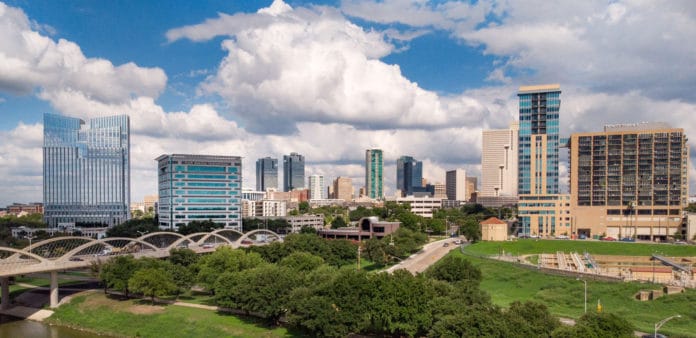Notice a few more people in Fort Worth? The U.S. Census Bureau has.
The U.S. Census Bureau 2019 population estimates show Fort Worth jumping from 15th to 13th largest city in the United States with a population of 895,008. Fort Worth gained 19,552 residents in 2018, climbing ahead of Columbus, Ohio and San Francisco.
“Fort Worth’s rapid growth speaks to our incredible quality of life, business friendly climate and affordable cost of living,” said Betsy Price, Mayor of Fort Worth. “Of course, substantial growth presents both great opportunities as well as new challenges to strategically manage our growth without compromising what makes Fort Worth a unique place to live, work, and play.”
Mayor Price and community leaders’ credit recent efforts focused around economic development, education, workforce development, and health and wellness for having a positive impact. The nation is taking notice of what Fort Worth has to offer, as Fort Worth saw the 3rd largest population increase in the U.S.
“The jump to 13th largest city in the U.S. will boost Fort Worth’s recognition worldwide as a formidable city in its own right and help draw more visitors and business investments,” said Bill Thornton, president & CEO of the Fort Worth Chamber of Commerce. “The Dallas-Fort Worth region — now 4th largest metro nationwide — and the Texas brand continue to attract business and top talent to fuel our economy. When people see that Fort Worth is larger than San Francisco, it should pique some curiosity about what’s going on here.”
The South and West continue to have the fastest-growing cities in the United States, according to new population estimates for cities and towns released by the U.S. Census Bureau. Among the 15 cities or towns with the largest numeric gains between 2017 and 2018, eight were in the South, six were in the West, and one was in the Midwest.
Many of those are in Texas with several in Collin County.. Phoenix, was at the top of the list with an increase of 25,288 people. Rounding out the top five with the largest population increases were San Antonio(20,824); Fort Worth,(19,552); Seattle (15,354); and Charlotte, N.C. (13,151).
Cities in the South that experienced a surge in population growth were Austin (12,504); Jacksonville, Fla. (12,153); Frisco (10,884); McKinney (9,888); and Miami (8,884). Cities in the West were San Diego(11,549); Denver, Colo. (11,053); Henderson, Nev. (10,759); and Las Vegas, Nev. (9,016). Columbus, Ohio (10,770), was the only city from the Midwest on the top 15 list.
Ten incorporated places exceeded the 50,000 population mark in 2018 — seven in the South, two in the West, and one in the Midwest. These cities and towns were Madison, Ala. (50,440); Maricopa, Ariz. (50,024); Bentonville, Ark. (51,111); Newark, Ohio (50,029); Stillwater, Okla. (50,391); Smyrna, Tenn. (50,775); Leander, Texas (56,111); Little Elm, Texas (50,314); Wylie, Texas (51,585); and Lacey, Wash. (50,718).
The Census count also shows that big cities in the U.S. aren’t growing like they used to.
Most of the nation’s largest cities last year grew by a fraction of the numbers they did earlier in the decade, according to population and housing unit estimates released Thursday by the U.S. Census Bureau.
The previous growth big cities had experienced in the first half of the decade was fueled by millennials who delayed home-buying in the suburbs after the recession and stuck it out in large cities, said William Frey, a senior fellow at The Brooking Institution’s Metropolitan Policy Program.
The recession’s aftermath “stranded a lot of millennials in cities rather than their moving off to the suburbs,” Frey said.
The Census data released Thursday looked at changes in cities and towns from mid-2017 to mid-2018. The data don’t reflect changes in metropolitan areas comprising multiple cities, towns, suburbs and counties.
The weakening in growth appears to have started two years ago, and accelerated last year.
Perhaps no other city offers as stark an example of the trend than New York City, the nation’s most populous city with just under 8.4 million residents last year. Even though the city has grown by 223,000 residents since 2010, the most of any city over the past eight years except Houston, most of the growth was in the early part of the decade. At its height, New York City grew by more than 82,000 residents in 2011, but it lost 39,000 residents last year.
Last month, when the U.S. Census Bureau released county-level data that showed identical population loss, New York City’s planners took umbrage with the federal agency’s methodology, saying international migrants were undercounted.
“While population growth has likely slowed, the Census Bureau’s methodology is not robust enough to precisely quantify the magnitude of these year-to-year changes,” the planners said on the city website.
With the exceptions of Phoenix and San Antonio, the phenomenon of slowing growth in the nation’s largest cities also has hit Sunbelt cities including Los Angeles, Houston and Dallas, where the populations grew, but at a fraction of their growth six years ago. San Jose, California, lost more than 2,000 residents last year.
“There is a growing moving away from cities,” Frey said. “The first part of the decade was an aberration. Cities were growing faster than suburbs. That is starting to turn around.”








